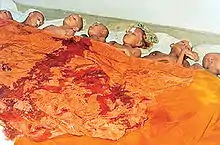Aranthalawa massacre
The Aranthalawa massacre was the massacre of 33 Buddhist monks, most of them young novice monks, and four civilians by cadres of the rebel Liberation Tigers of Tamil Eelam organization (the LTTE, commonly known as the Tamil Tigers) on June 2, 1987, close to the village of Aranthalawa, in the Ampara District of Eastern Sri Lanka. The massacre is considered one of the most notorious and devastating atrocities committed by the LTTE during the history of the Sri Lankan Civil War, and continues to be commemorated 20 years on.
| Aranthalawa massacre | |
|---|---|
 Dead bodies of young Buddhist monks lying on floor, after they were massacred on 2 June 1987 | |
| Location | Aranthalawa, Sri Lanka |
| Coordinates | 7°31′33.3″N 81°28′35.4″E |
| Date | June 2, 1987 (UTC+5:30) |
| Deaths | 37 |
| Perpetrator | Liberation Tigers of Tamil Eelam |
The massacre
The Aranthalawa Massacre took place on June 2, 1987,[1] when a bus carrying Buddhist monks and a few unarmed civilians was ambushed by 20[2] armed LTTE cadres near the village of Nuwaragalatenna,[3][4] led by an LTTE leader named Reagan.[5] They then ordered the driver of the bus, which was carrying the monks on a pilgrimage from their temple in Mahavapi to the Kelaniya Raja Maha Vihara,[2] to drive into the nearby Aranthalawa jungle. After the bus stopped, the LTTE cadres went on a rampage, attacking the monks with guns and swords[6] and also shooting some of them with machine guns.
Among the dead were 30 young novice monks and their mentor, the Chief Priest of the Vidyananda Maha Pirivena, Hegoda Sri Indrasara Thera.[6] Four civilians who were traveling in the bus were also among the dead.[7]
Three monks who escaped the massacre sustaining critical injuries continue to require medical assistance. Another monk was permanently disabled.[8]
Motives
The Divaina newspaper viewed the attack as a LTTE attempt to increase animosity between the two races and cause a Sinhalese backlash against Tamil civilians, which would increase support and funding towards their violent campaign.[9]
Reactions
Theravada monks are incapable of defending themselves. The harming of monk is considered to be one of the highest offenses in Theravada Buddhism or even among Hindu. The massacre is considered to be one of the most brutal attacks carried out during the conflict in Sri Lanka.[10]
Each year Aranthalawa Massacre is commemorated by a series of special programs.[11] In 2007, to coincide with the 20th anniversary of the massacre, commemorations were held over the course of four days in Colombo and Ampara, with the main ceremony led by Sri Lanka President Mahinda Rajapaksa taking place in Colombo with the participation of the Mahanayake Theras of all Chapters. An all night Pirith ceremony was held on the same night, and a Sanghika Dāna was offered to 200 Buddhist monks on June 3. An exhibition of over 300 photographs of LTTE attacks on Buddhist sites and other acts of destruction was also organized.[8]
A plaque has since been constructed close to the site of the incident to commemorate the massacre.[7]
Retaliation
One of the Tigers who committed the massacre was a local leader called Reagan from Vellaveli.[5] In retaliation the Special Task Force unit of the Sri Lankan security forces ordered Reagan's family members to stand before them in their Vellaveli homes, and after reading their names from a list, shot them to death and dismembered their bodies.[5]
Similar attacks
Throughout the course of the conflict in Sri Lanka, the LTTE has carried out a number of similar attacks against Buddhist sites. These include:
- an attack on the Jaya Sri Maha Bodhi, killing around 146 pilgrims.[6]
- the assassination of the high priest of the famous Dimbulagala Forest monastery, Kithalagama Seelalankara Nayaka Thera, who gave moral support to people living in border villages to fight LTTE intrusions into their villages, eight years after the Aranthalawa Massacre.[3][6]
- a suicide bombing of the Temple of the Tooth, the sacred Buddhist shrine where the Buddha’s tooth relic is enshrined, which killed 17 worshipers and seriously damaged the temple.[6]
- a suicide bombing of a Buddhist temple in Batticaloa during celebrations of the Vesak holiday, killing 23 people including many children.[12]
References
- "Arantalawa massacre - June 2nd 1987". Lanka Library. 2007-06-08. Archived from the original on 2017-02-11. Retrieved 2007-06-05.
- "LTTE's gun culture continues". The Sunday Observer. 2007-06-03. Archived from the original on 2007-06-30. Retrieved 2007-06-06.
- "Assassination of Hadungamuwe Nandaratne Thera". Jayampathy Jayasinghe. Sunday Observer. May 20, 2007. Archived from the original on September 30, 2007. Retrieved June 2, 2007.
- Athas, Iqbal (1996-10-15). "East: a prize catch, thinks LTTE". The Sunday Times. Retrieved 2007-06-05.
- Lawrence, Patricia (2000-10-02). "Violence, Suffering, Amman: The Work of Oracles in Sri Lanka's Eastern War Zone". In Das, Veena; Kleinman, Arthur (eds.). Violence and Subjectivity. University of California Press. p. 172. ISBN 0520216083. Retrieved 30 July 2019.
- Jayawardhana, Walter (2006-07-10). "LTTE attempts to arouse religious clash, fades". Ministry of Defence, Sri Lanka. Archived from the original on 2007-10-09. Retrieved 2007-06-02.
- "Three LTTEers killed by STF". Rafik Jalaldeen. Daily News. February 15, 2007. Archived from the original on September 30, 2007. Retrieved June 2, 2007.
- Gunatilleke, Nadira (2007-05-24). "Aranthalawa commemoration from May 31 to June 3". Daily News. Archived from the original on 2007-09-30. Retrieved 2007-06-02.
- "The aranthalawa bhikku massacre". Divaina, Editorial. June 2, 2000.
- "Aranthalawa massacre, one of the darkest chapters in Lankan history - Ven. Kirindiwela Somarathana Thera". Nadira Gunatilleke. The Daily News. May 24, 2007. Archived from the original on February 7, 2009.
- "Marking 20 years anniversary of the Aranthalawa assassination". Government News Portal of Sri Lanka. 2007-05-23. Retrieved 2007-06-02.
- United States Department of State (February 23, 2001). "Sri Lanka". Country Reports on Human Rights Practices - 2000. Archived from the original on June 7, 2001. Retrieved 2007-06-02.